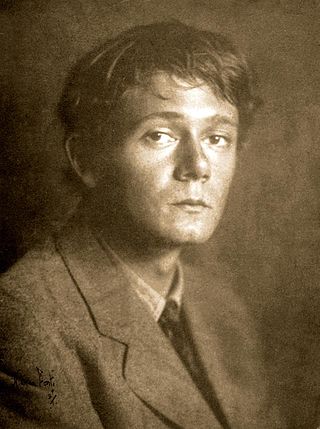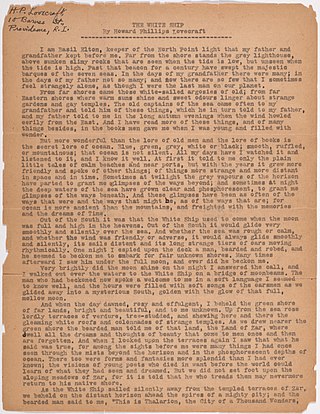
Clark Ashton Smith was an American writer and artist. He achieved early local recognition, largely through the enthusiasm of George Sterling, for traditional verse in the vein of Swinburne. As a poet, Smith is grouped with the West Coast Romantics alongside Joaquin Miller, Sterling, and Nora May French and remembered as "The Last of the Great Romantics" and "The Bard of Auburn". Smith's work was praised by his contemporaries. H. P. Lovecraft stated that "in sheer daemonic strangeness and fertility of conception, Clark Ashton Smith is perhaps unexcelled", and Ray Bradbury said that Smith "filled my mind with incredible worlds, impossibly beautiful cities, and still more fantastic creatures".

Howard Phillips Lovecraft was an American writer of weird, science, fantasy, and horror fiction. He is best known for his creation of the Cthulhu Mythos.

The Case of Charles Dexter Ward is a short horror novel by American writer H. P. Lovecraft, written in early 1927, but not published during the author's lifetime. Set in Lovecraft's hometown of Providence, Rhode Island, it was first published in the May and July issues of Weird Tales in 1941; the first complete publication was in Arkham House's Beyond the Wall of Sleep collection (1943). It is included in the Library of America volume of Lovecraft's work.
"Supernatural Horror in Literature" is a 28,000-word essay by American writer H. P. Lovecraft, surveying the development and achievements of horror fiction as the field stood in the 1920s and 30s. The essay was researched and written between November 1925 and May 1927, first published in August 1927, and then revised and expanded during 1933–1934.
This is a complete list of works by H. P. Lovecraft. Dates for the fiction, collaborations and juvenilia are in the format: composition date / first publication date, taken from An H. P. Lovecraft Encyclopedia by S. T. Joshi and D. E. Schultz, Hippocampus Press, New York, 2001. For other sections, dates are the time of composition, not publication. Many of these works can be found on Wikisource.

Weird fiction is a subgenre of speculative fiction originating in the late 19th and early 20th centuries. Weird fiction either eschews or radically reinterprets traditional antagonists of supernatural horror fiction, such as ghosts, vampires, and werewolves. Writers on the subject of weird fiction, such as China Miéville, sometimes use "the tentacle" to represent this type of writing. The tentacle is a limb-type absent from most of the monsters of European gothic fiction, but often attached to the monstrous creatures created by weird fiction writers, such as William Hope Hodgson, M. R. James, Clark Ashton Smith, and H. P. Lovecraft.
"The Unnamable" is a horror short story by American author H. P. Lovecraft. It was written in September 1923, first published in the July 1925 issue of Weird Tales, and first collected in Beyond the Wall of Sleep. The corrected text appears in Dagon and Other Macabre Tales,. The story's locale was inspired by the Charter Street Historic District Burying Ground in Salem.

"The White Ship" is a horror short story by American writer H. P. Lovecraft. It was first published in The United Amateur #2, November 1919, and later appeared in the March 1927 issue of Weird Tales.
Farnsworth Wright was the editor of the pulp magazine Weird Tales during the magazine's heyday, editing 179 issues from November 1924 to March 1940. Jack Williamson called Wright "the first great fantasy editor".
"Polaris" is a fantasy short story by American author H. P. Lovecraft, written in 1918 and first published in the December 1920 issue of the amateur journal The Philosopher. It is the story that introduces Lovecraft's fictional Pnakotic Manuscripts, the first of his arcane tomes.

"Facts Concerning the Late Arthur Jermyn and His Family" is a short story in the horror fiction genre, written by American author H. P. Lovecraft in 1920. The themes of the story are tainted ancestry, knowledge that it would be best to remain unaware of, and a reality which human understanding finds intolerable.

"Cool Air" is a short story by the American horror fiction writer H. P. Lovecraft, written in March 1926 and published in the March 1928 issue of Tales of Magic and Mystery.
"The Picture in the House" is a short story written by H. P. Lovecraft. It was written on December 12, 1920, and first published in the July issue of The National Amateur—which was published in the summer of 1921. It was reprinted in Weird Tales in 1923 and again in 1937.

"The Strange High House in the Mist" is a short story by H. P. Lovecraft. Written on November 9, 1926, it was first published in the October 1931 issue of Weird Tales. It concerns a character traveling to the titular house which is perched on the top of a cliff which seems inaccessible both by land and sea, yet is apparently inhabited.

Edgar Hoffmann Trooper Price was an American writer of popular fiction for the pulp magazine marketplace. He collaborated with H. P. Lovecraft on "Through the Gates of the Silver Key".

"The Moon-Bog" is a short story by American horror fiction writer H. P. Lovecraft, written in or before March 1921. The story was first published in the June 1926 issue of the pulp magazine Weird Tales.
Tryout was an amateur press journal published from 1914 to 1946 by Charles W. Smith of Haverhill, Massachusetts. It was connected to the National Amateur Press Association.
The Loved Dead is a story written by C. M. Eddy Jr. in 1919. A controversial tale of necrophilia, it was published in Weird Tales bumper issue for May/July 1924.
William Paul Cook was a writer, printer and publisher. He wrote under his own name and the pseudonym Willis T. Crossman and was a leading figure in amateur journalism. He lived and wrote mostly in Vermont and Massachusetts.

The Best of H. P. Lovecraft: Bloodcurdling Tales of Horror and the Macabre is a collection of stories by American author H. P. Lovecraft. It was first published in trade paperback by Del Rey/Ballantine in October 1982 as a volume in its Classic Library of Science Fiction, and reprinted in September 1988 and April 1995, with an ebook edition issued in November. 2002.











